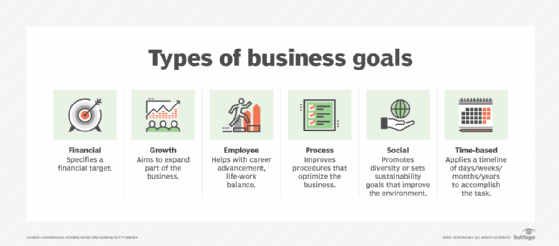Setting goals is crucial for beginning and running a business. Without a business goal, you may find yourself floundering in your business without direction. Your goals can help you focus on where you want to be, and help you plan to get there. What is the business goal? We‘ll cover all you need to know to develop objectives for your business, whether you’re looking at the broad picture or seeking for modest stepping stones.
What is The Business Goal?
A business goal is a predefined goal that a business or individual plans to achieve within a certain period of time. These goals are usually divided into short-term goals and long-term goals. Business goals can take many different forms and are aspirational or motivational, such as driving the organization toward a certain goal such as improving customer service. They may also have very specific goals, such as achieving a specific revenue goal, net income, profit margin, profit goal, or another financial milestone.

Why are Business Goals important?
Setting business goals is best practice for a reason- goals that help propel the business in the right direction. The main benefit of using business goals is to bring teams together towards a common goal. Setting clear business goals allows team leaders to determine what tactics their individual teams should use to achieve these goals.
Furthermore, setting business goals can help maintain accountability from the top level down to individual team members. When each team member is held accountable for their individual goals, it’s easier for managers to gauge their performance and when they may need additional support. Business objectives provide milestones that can help an organization measure its success or failure.

Different types of Business Goals
- Financial goals: These goals are often specific financial goals a company wants to achieve in order to increase sales or profits.
- Growth goals: This type of goal is intended to expand or grow a part of the business by a certain percentage. Growth can be about new products, customers or locations.
- Social goals: Social goals, such as promoting diversity or setting sustainability goals for environmental concerns, cutting greenhouse gas emissions or reducing carbon emissions are increasing categories strategic and important in the goal-setting process.
- Time-based goals: Time-based goals include short-term as well as long-term goals and objectives. Short-term goals can be completed in days, weeks, or months, while long-term goals have completion dates that span months to years.
How to set business goals?
Short-term business goals
– Step 1: Identify short-term goals
The first step in setting short-term business goals is to figure out what goals you want to achieve within a certain period of time. Many short-term goals are those that continue to achieve long-term goals.
– Step 2: Break down each goal
Next, you should break down each short-term goal into achievable goals. These goals should represent the steps your company will take to achieve each goal.
– Step 3: Assign tasks to employees
Once you’ve established goals for each short-term goal, assign each goal to an employee or group of employees who will work through the goal until it’s done.
– Step 4: Check your progress regularly
Regularly measure progress on your short-term goals to make sure you’re on track to meet them within the timeframe you’ve established. Monitor progress and adjust goals as needed to achieve better goals.
Long-term business goals
– Step 1: Set goals
The first step to creating a long-term business goal is to define what you want to achieve in the next few years. Many people find that setting goals for 10 years are enough; However, you can set goals within a year or as far as 20 years.
– Step 2: Prioritize long-term goals
Many companies have several goals that they want to achieve in the long term. However, it is difficult to focus on every goal at the same time. For this reason, it’s important to prioritize the goals you want to focus on first and put the company’s resources into accomplishing those goals before moving on to other goals.
– Step 3: Break down each long-term goal
Similar to how you break down short-term goals, you’ll also need to break down your long-term goals into achievable short-term goals.
– Step 4: Follow up
An important component of accomplishing long-term goals is tracking them on a regular basis. Because long-term goals can take a long time to achieve, it’s easy to forget them or lose sight of the end goal.
Tips for achieving business goals

- Clearly define your goals: Start by setting clear, measurable, and achievable goals that align with your overall business strategy.
- Create a plan: Develop a detailed plan that outlines the steps you need to take to achieve your goals. This should include deadlines, resources, and accountability.
- Involve your team: Encourage team members to contribute their ideas and involve them in the implementation process. A shared sense of ownership can help drive success.
- Prioritize: Focus on the most important goals first and allocate resources accordingly.
- Monitor progress: Regularly track your progress and adjust your plan as needed. This will help you stay on track and make course corrections as needed.
- Stay flexible: Be prepared to adapt to changing circumstances and adjust your plans if needed.
- Celebrate success: Recognize and reward your team when you reach milestones and reach your goals. This can help maintain motivation and momentum.
Conclusion
All businesses start small and the goal is how they grow into successful companies. Taking the time to set goals for your business and creating individual goals to help you achieve each goal can greatly increase your chances of achieving those goals. Remember, success is not always immediate and may require perseverance, but with the right approach, it can be achievable.


